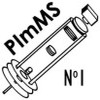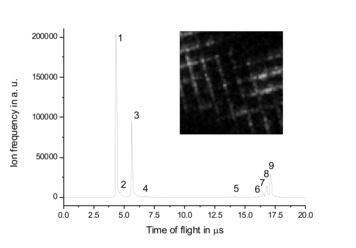MenuApplicationsSpatial Imaging of Chemical Compounds Velocity Mapping Coincidence Imaging Molecular Motion Tissue Imaging DevelopmentFast Scintillators Direct Ion Detection |
Spatial Imaging of Chemical CompoundsMass spectrometry is a powerful analytical technique of which there are a number of different variations. Time-of-flight mass spectrometry seperates a sample into species with different mass to charge (m/z) ratios. A sample is desorbed into the gas phase and ionised. These ions are accelerated by an electric field and species with different m/z ratios reach different final velocities. These species then arrive at the detector at a time corresponding to their m/z ratio. By controlling the curvature of the accelerating field, it is also possible to control the position on the detector at which the ions hit. With the correct field ions can be made to map onto the detector dependent on their initial position when they were ionised. This means that not only is the chemical information extracted from the time-of-flight, but the original position of a given ion is observed. One type of detector used in these experiments consists of microchannel plates which convert incident ions into a shower of electrons amplifying the signal, followed by a scinitillating screen which converts these electrons into light. A camera can be used to capture the image relating to the m/z region of interest. By using the PImMS sensor in place of a standard framing camera, all images for all m/z ratios can be obtained within the same experimental cycle. This can greatly reduce the time needed to collect a full data set. Related Publications |




